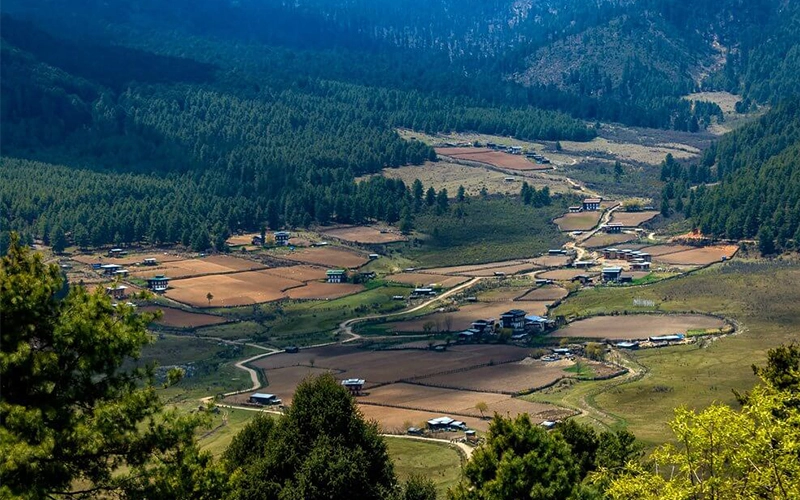Bhutan’s monsoon season brings unique charm to its stunning landscapes. While trekking might not be ideal due to rainfall, the serene beauty and rich cultural experiences in July make it a wonderful time to visit some of Bhutan’s most cherished sites. Here are some highlights:
Phobjikha Valley

A tranquil valley on the slopes of the Black Mountains, Phobjikha is known for its natural beauty and biodiversity. Though July brings heavy rain, the valley’s lush landscape becomes even more captivating.
Facts: Phobjikha Valley is celebrated for its large flocks of endangered blacknecked cranes, which migrate here in winter. The area is a haven for nature enthusiasts, with numerous species including wild boars, mountain bears, and red foxes.
Main Highlights: The scenic valley and diverse wildlife make it one of Bhutan’s most valuable natural preserves.
Travel Tips: While winter is the best time to see the cranes, July offers a quieter, rainsoaked experience in Bhutan’s countryside.
Tiger’s Nest Monastery (Taktsang Monastery)

An iconic pilgrimage site, Tiger’s Nest Monastery clings dramatically to a cliff in Paro Valley. The trek to reach it offers breathtaking views and a powerful cultural experience.
Facts: Built in the 17th century, this monastery is said to be where Guru Rinpoche meditated, establishing Buddhism in Bhutan.
Main Highlights: The panoramic view of Paro Valley below is unparalleled.
Travel Tips: While the rainy season can make trekking challenging, fewer visitors mean you’ll have a peaceful experience.
Kurjey Lhakhang Monastery
A significant historical and spiritual site in Bhutan, this monastery is where Guru Rinpoche is said to have left his body imprint.
Facts: This monastery is also the final resting place for Bhutan’s first three kings.
Main Highlights: The lush valley view and serene atmosphere make it a beautiful place to visit.
Travel Tips: The monastery is accessible in July, and the rain enhances the lush surroundings, creating a tranquil ambiance.
Thimphu
Bhutan’s capital is an intriguing mix of tradition and modernity, featuring markets, landmarks, and a unique pedestrian experience.
Facts: Thimphu was designated the capital in 1961.
Main Highlights: Experience the lively Weekend Market and the blend of traditional and modern lifestyles as locals in national dress walk alongside trendy youth.
Travel Tips: July’s rain adds a mystical atmosphere to the city, ideal for a quieter experience.
Trashi Chhoe Dzong

A grand fortress and monastery, Trashi Chhoe Dzong is a peaceful retreat with manicured gardens.
Facts: Initially built in the 18th century, the dzong was renovated in 1962 to serve both government and religious purposes.
Main Highlights: Its beautiful white exterior with a red roof, situated beside the river with the hills as a backdrop, is picture-perfect.
Travel Tips: Open throughout the week, it’s an easy stop for a calm escape, even during the monsoon.
Deer Park, Thimphu
Established in 2007, Deer Park is a center for art and meditation, inspired by the teachings of the Buddha.
Facts: Named after the Deer Park in Sarnath, where Buddha first taught, it symbolizes openness and compassion.
Main Highlights: Participate in events and cultural activities hosted here, drawing people worldwide.
Travel Tips: July may bring fewer visitors, offering a quiet, reflective experience.
The Druk Wangyal Chortens and Temple at Dochula Pass

This pass offers panoramic views of the Himalayas and the colorful prayer flags fluttering in the wind, creating an aweinspiring scene.
Facts: Located at 3,100 meters, Dochula Pass is home to chortens (stupas) built to honor Bhutan’s peaceful traditions.
Main Highlights: The Druk Wangyal Temple and the war memorial add historical depth to this scenic site.
Travel Tips: Though July’s rain can make travel challenging, the clouds over the mountains create a mystical atmosphere.
Haa Valley
Close to the India-China border, Haa Valley is an isolated paradise with stunning landscapes and cultural experiences.
Facts: Opened to the public in 2002, the valley remains largely untouched and offers a glimpse into Bhutan’s rural life.
Main Highlights: The gentle treks, cultural exchanges, and dramatic scenery make Haa Valley a gem.
Travel Tips: Spring is ideal for blooms, but July is perfect for solitude amid Bhutan’s lush landscape.
The National Museum of Bhutan

Perched on a hill above Paro Dzong, this museum offers a fantastic collection of Bhutanese art and history.
Facts: Originally a watchtower, it was converted into a museum in 1968 and shaped to resemble a conch shell.
Main Highlights: Explore thangkas, festival masks, and stone carvings.
Travel Tips: July is a great time to dive into Bhutan’s history indoors, away from the rain.
These destinations in Bhutan showcase the country’s rich heritage, natural beauty, and serene atmosphere. A visit in July offers a quieter experience, with lush landscapes enhanced by the monsoon season’s magic.

